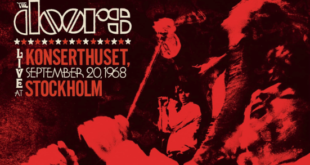Blues-rock powerhouse Beth Hart might not, as she quipped the other night at Town Hall, “have any hits,” but she’s got what’s more important: the stage presence and musical chops to keep her devoted following rapt.
During a blistering near-two-hour set the other night, Hart and her band roamed through seething, piano-based originals, a few numbers from her towering new A Tribute to Led Zeppelin album, and a couple of other deep-soul covers. No “hits” needed; although it seemed many in the audience didn’t recognize most of the originals, Hart had the crowd wrapped around her as tightly as the tattoos on her expressive arms.
Quinn Sullivan: From Blues Guitar Wunderkind to Blue-Eyed Soul
The crowd had been juiced up by 22-year-old Quinn Sullivan, the onetime child prodigy blues guitarist. His tempered stage persona could hardly be more different than Hart’s manic one, but his blue-eyed-soul effectively set the stage. Sullivan has a knack for pop-tinged songwriting and a winning tenor voice to go with it. His well-known six-string skills fuel both.
Buddy Guy championed the very young Sullivan, taking him on the road when he was just 10. Along with that legendary bluesman’s influence, Sullivan’s soloing brought to mind the fervor of Eric Clapton and the melodic snap and milky tone of the Allman Brothers. With only one backing musician (on electric mandolin and keyboards), the guitarist fully unleashed his blues power on a rocking jam during the Derek and the Dominos classic “Why Does Love Got to Be So Sad?”

Sullivan’s own songs are tightly constructed, with good hooks and enough pop appeal that one can imagine him breaking into a wider fan demographic than the rarefied one that’s looking for the next Joe Bonamassa. That was especially clear in his single “How Many Tears,” a somewhat by-the-numbers soul-pop tune that he elevated, literally, by soaring into an assured falsetto that drew cheers. (Were some among the many middle-aged fans recalling a groupie youth?) He hasn’t left the blues behind, though. “In a World Without You,” a dark, funky rocker, featured a jagged jam with a powerful groove.
The guitar-mandolin combo lacked the low end that would have made a few of the more sophisticated chord changes clearer. But the pair played with such inspired energy, and so in the groove, that it hardly mattered. Often one senses impatience during an opening act. Not so here: the crowd embraced Sullivan warmly.
Beth Hart: At Home with Led Zeppelin and Etta James
Beth Hart kicked off her set with a few classics from her Led Zeppelin tribute album. She strutted and gesticulated like Mick Jagger, sank to her knees, and kept mostly to the cool low end of her range, where the tension lies, bestowing the release of letting loose only at calculated moments. Throughout the set she sustained this near-ideal union of skillfully curated musical effects with sincere emotional rawness.

Introductory stories about her troubled family history and struggles with addiction deepened our connection with the songs. She dismissed the band long enough to play a few deeply soulful numbers by herself at the piano. And when she brought the backing musicians back on stage, rather than returning to the initial rock quartet format they took up acoustic instruments, finishing up in a folk-like lineup, seated in a row downstage.
Highlights of the set included an almost spasmodic “Sugar Shack,” a dramatic “Rub Me for Luck,” and “Bad Woman Blues,” which brought to mind Patty Smith’s “Because the Night.”
Perhaps most affecting of all was “Tell Her You Belong to Me.” The title naturally suggests a love triangle, but the impassioned song gained depth from our knowing that it was about a father whose new partner is keeping him and his young daughter apart. (And it contains one of the best lines I’ve heard in a long time: “She’ll never kiss you the way that I miss you.”)
A very slow version of the Etta James ballad “I’d Rather Go Blind” provided a broad empty canvas for Hart and her band to fill, deliberately, grippingly, with all the colors of the musical rainbow. Live, her own songs feel that way too – in each she creates a world of feeling and sound. They’re performances in the deepest sense of the word – both musical and theatrical, and supremely real.
 Blogcritics The critical lens on today's culture & entertainment
Blogcritics The critical lens on today's culture & entertainment




